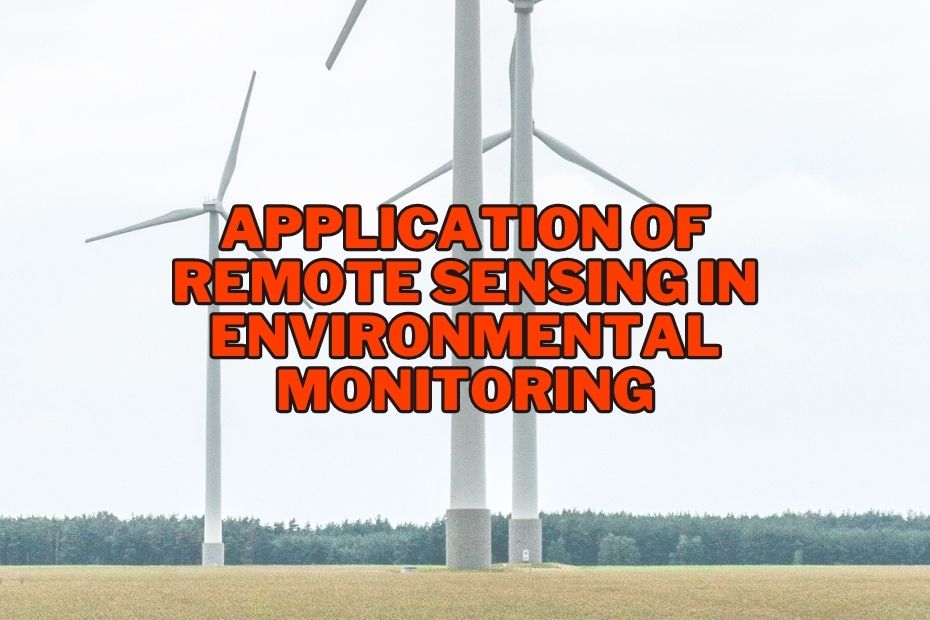In today’s rapidly changing world, environmental monitoring plays a vital role in understanding and managing our planet’s ecosystems. Remote sensing, a technology that enables the collection of data from a distance, has revolutionized environmental monitoring. By utilizing various sensors and satellite imagery, remote sensing offers valuable insights into the Earth’s natural resources and the impact of human activities. In this article, we will explore eleven key application of remote sensing in environmental monitoring.
Remote sensing plays a crucial role in environmental monitoring by providing extensive data on land, water, and atmospheric conditions. This information is essential for understanding environmental changes, detecting pollution, assessing natural resources, and monitoring the impact of human activities.
Application of Remote Sensing In Environmental Monitoring
Remote sensing encompasses a wide range of techniques and applications. Let’s delve deeper into how it works and its key applications in environmental monitoring.
1. Land Cover Classification and Mapping
Remote sensing allows for accurate and efficient land cover classification and mapping. By analyzing satellite imagery, it becomes possible to identify different land cover types such as forests, agricultural lands, water bodies, and urban areas. This information helps in monitoring changes in land use patterns, detecting deforestation, and planning sustainable land management practices.
2. Forest Health Assessment
Remote sensing facilitates the assessment of forest health by analyzing various indicators such as vegetation indices, canopy density, and forest structure. By monitoring changes in these parameters, researchers and forest managers can detect signs of diseases, pests, and stress factors that affect the overall health of forests. Timely detection allows for proactive measures to mitigate potential threats and preserve forest ecosystems.
3. Climate Change Analysis
Understanding the impact of climate change is crucial for devising effective mitigation and adaptation strategies. Remote sensing provides valuable data on key climate variables such as temperature, precipitation, and vegetation dynamics. By monitoring changes over time, scientists can analyze trends, model climate scenarios, and assess the impact of climate change on ecosystems and vulnerable regions.
4. Water Quality Monitoring
Remote sensing plays a significant role in monitoring water quality in lakes, rivers, and coastal areas. By analyzing satellite imagery and sensor data, scientists can detect parameters such as water temperature, turbidity, chlorophyll concentration, and pollutants. This information helps in identifying potential sources of contamination, tracking algal blooms, and managing water resources more effectively.
5. Coastal Zone Management
Coastal zones are highly dynamic and sensitive environments that require careful monitoring and management. Remote sensing enables the mapping and monitoring of coastal features, including shoreline changes, erosion rates, and sediment transport. This data aids in coastal zone planning, assessing the vulnerability of coastal communities to sea-level rise, and preserving valuable ecosystems such as coral reefs and wetlands.
6. Disaster Management
Remote sensing plays a crucial role in disaster management by providing timely and accurate information for response and recovery efforts. Satellite imagery can help identify disaster-affected areas, assess damages, and support search and rescue operations. Remote sensing also aids in monitoring post-disaster changes, enabling efficient allocation of resources and planning for future events.
7. Air Quality Monitoring
Monitoring air quality is essential for understanding the impact of pollutants on human health and the environment. Remote sensing techniques, such as hyperspectral imaging and atmospheric monitoring, provide valuable data on air pollutants, including particulate matter, ozone, and nitrogen dioxide. This information aids in assessing air quality patterns, identifying pollution sources, and formulating effective air quality management strategies.
8. Agriculture and Crop Monitoring
Remote sensing is widely used in agriculture to monitor crop health, optimize irrigation, and enhance yield prediction. By analyzing satellite imagery and vegetation indices, farmers and researchers can identify areas of stress, nutrient deficiencies, and disease outbreaks in crops. This enables targeted interventions, precise resource allocation, and sustainable farming practices.
9. Biodiversity Conservation
Understanding and conserving biodiversity is crucial for maintaining healthy ecosystems. Remote sensing assists in mapping and monitoring biodiversity by analyzing vegetation indices, habitat characteristics, and species distribution patterns. This information aids in identifying biodiversity hotspots, tracking habitat changes, and supporting conservation initiatives.
10. Urban Planning and Development
Remote sensing provides valuable data for urban planning and development. By analyzing satellite imagery and LiDAR data, city planners can monitor urban growth, assess land suitability, and plan infrastructure projects more effectively. Remote sensing also helps in analyzing urban heat islands, managing green spaces, and monitoring the impact of urbanization on surrounding ecosystems.
11. Geological and Geomorphological Studies
Remote sensing techniques are instrumental in geological and geomorphological studies. By analyzing satellite imagery, researchers can map geological formations, study landforms, and identify potential natural hazards. This information aids in geological surveys, mineral exploration, and assessing the risk of landslides, volcanic eruptions, and earthquakes.
Conclusion
Remote sensing has transformed the field of environmental monitoring, enabling us to gather valuable data on a global scale. From land cover classification to disaster management and biodiversity conservation, the applications of remote sensing are diverse and far-reaching. By harnessing the power of this technology, we can make informed decisions, implement sustainable practices, and protect our planet’s fragile ecosystems.
FAQs: Application of Remote Sensing In Environmental Monitoring
Can remote sensing detect climate change?
Remote sensing plays a crucial role in detecting and analyzing climate change. By monitoring key climate variables and analyzing trends over time, scientists can assess the impact of climate change on ecosystems and make predictions for the future.
How is remote sensing used in environmental monitoring?
It has multiple applications, including climate change monitoring, disaster management, water and air quality assessment, and more.
Can remote sensing help in tracking endangered species?
Yes, remote sensing aids in monitoring habitats, migration patterns, and population dynamics of endangered species, enabling targeted conservation efforts.
